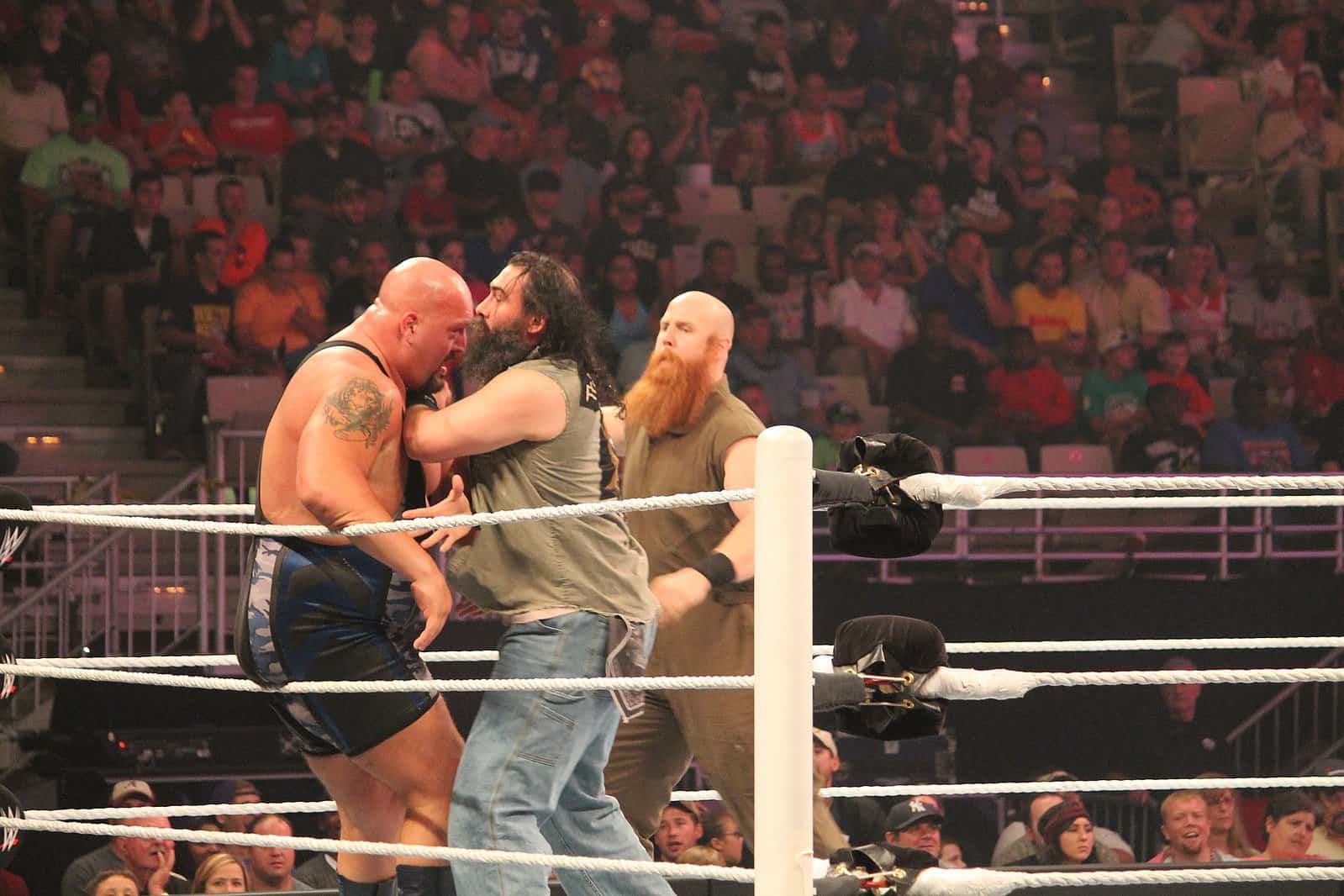Randon Herrera is a student at Harvard Law School.
For those who have yet to cue in, professional wrestling is fake—the conflicts are fabricated, the fights are choreographed, and the maneuvers are (in theory) designed to prevent injury. Yet, for anyone who has spent even a few minutes watching World Wrestling Entertainment (WWE), it should come as no surprise that the dangers of professional wrestling are very real. After all, there is only so much you can do to fake falling off a twenty-foot steel cage or being thrown onto a bed of thumbtacks.
Despite all the hell that they put their bodies through, however, WWE professional wrestlers have almost no power to change their working conditions. Since its inception, the WWE and its predecessors have maintained that their wrestlers are independent contractors, despite exercising considerable control over the wrestlers. Importantly, this means professional wrestlers are unable to unionize in order to bargain for better conditions. But largely because of a recent segment on Last Week Tonight with John Oliver, attention to the WWE’s misclassification of its wrestlers has been renewed.
Substance Abuse in the WWE
Andrew James Robert Patrick Martin, better known by his stage name “Test,” wrestled for the WWE from 1998 to 2007. Though Martin was never quite a superstar in the WWE, he showed promise and secured a main event card on several occasions. Towards the end of his career, he was in and out of the company, eventually retiring from wrestling altogether in 2009. Any chance of staging a comeback was cut short, when on March 13, 2009, Martin died of an accidental overdose of oxycodone. Medical examiners noted that Martin had severe brain damage in the form of chronic traumatic encephalopathy (CTE) due to repeated blows to the head during his time as a professional wrestler.
Andrew Martin’s story is not uncommon. It is a familiar pattern in the WWE: Wrestlers abuse their bodies night in and night out, they wrestle through injuries, injuries compound, and then drugs come into the picture. Unsurprisingly, because of the nature of the business, the rate of death among WWE wrestlers is high—more than double the national average at almost every age group. Much of this is due to drug abuse. For its part, the WWE has taken steps to respond to the rampant drug abuse, most notably by instituting strict drug testing under the Talent Wellness Program in 2006 following one of the most well-known and tragic WWE deaths. While drug violations have reportedly decreased in recent years, there are numerous ways for WWE wrestlers to cheat the system and get away with drug use. And regardless of its efficacy, the Wellness Program does little to address the root causes of substance abuse in the WWE.
WWE wrestlers under contract perform up to 200 shows a year, not including practices. As a result, injuries are common. The WWE covers all medical expenses for treatment and rehabilitation for all in-ring injuries suffered (but only these injuries). The problem is that wrestlers are often reluctant to seek treatment for their injuries, as there is a fear of repercussion if one comes forward with an injury—a fear that is not unfounded. Many contracts stipulate that a wrestler may forfeit pay or may even be terminated if they are injured for longer than a specified duration, even if the injury occurred in-ring. Andrew Martin himself had his contract terminated in 2004 after receiving a spinal procedure, forcing him to temporarily wrestle on an independent circuit.
Furthermore, the pay is not what it seems. While many WWE wrestlers are relatively well paid, others are not. Wrestlers in the company’s development circuit make as little as $35,000 per year. For others, the high pay is undermined by short careers. And regardless of their pay, WWE wrestlers receive no traditional employment benefits to supplement their pay, given their classification as independent contractors. Thus, it is only natural that wrestlers are cautious about reporting injuries. The flimsy pay, combined with the fear of losing their contracts, makes reporting an injury financially irresponsible.
Because of their reluctance to report injuries and the pressure to wrestle for their contracts, many WWE wrestlers turn to pain medication and steroids to sustain their performance. According to former wrestler Scott “Raven” Levy, who at one time was taking 200 pain pills per day: “If you want to be a wrestler you have to be a big guy, and you have to perform in pain.”
There are certainly other contributing factors to the rampant substance abuse in the WWE, such as a culture that promotes a “rock god lifestyle” and pressures to take steroids to obtain a “herculean” physique. But these facts only reinforce the idea that the WWE has a toxic culture that promotes drug use. And, with a revenue of over $900 million, there is little incentive for the WWE to make changes. That is why WWE wrestlers need a union, a power that they should, but do not have.
WWE Wrestlers Are Misclassified
In its SEC filing, the WWE continuously reaffirms that its professional wrestlers are independent contractors. However, based on the amount of control that it exercises over its wrestlers, the WWE is in all likelihood misclassifying its wrestlers. According to a complaint alleging misclassification by three former wrestlers against the WWE, the WWE exercises control over its contracted wrestlers in almost every respect. The WWE controls wrestlers’ training regimen; where and when wrestlers perform; who wrestlers perform with and against; the duration and outcome of matches; what costumes wrestlers wear; the wrestlers’ personas and signature moves; and the wrestlers’ roles and dialogues during storylines. The WWE also maintains the right to use wrestlers’ likeness in perpetuity, unilaterally determines wrestlers’ pay, and, most importantly, forbids its wrestlers from holding any other occupation while under contract with the WWE. Had the case above not been dismissed on procedural grounds, it likely would have succeeded due to the WWE’s sweeping control over its wrestlers.
Conclusion
Being properly classified as employees would give WWE wrestlers the ability to unionize, which in turn would give them the power to negotiate for better working conditions. Through collective bargaining, wrestlers could bargain for better contracts—ones that don’t lead to termination after serious injury; they could bargain for fewer performances per year; and, among other things, they could bargain for much needed employment benefits such as health insurance and pensions.
With the rise of the gig economy drawing people’s attention to the issue of worker misclassification, in addition to John Oliver bringing the issue of wrestler misclassification to the fore, now is the time for advocates to step up to vindicate wrestlers’ workplace rights. As the former WWE wrestler Ryback recently stated: “[T]his is the best time for something to be done.”






Daily News & Commentary
Start your day with our roundup of the latest labor developments. See all
December 12
OH vetoes bill weakening child labor protections; UT repeals public-sector bargaining ban; SCOTUS takes up case on post-arbitration award jurisdiction
December 11
House forces a vote on the “Protect America’s Workforce Act;” arguments on Trump’s executive order nullifying collective bargaining rights; and Penn State file a petition to form a union.
December 8
Private payrolls fall; NYC Council overrides mayoral veto on pay data; workers sue Starbucks.
December 7
Philadelphia transit workers indicate that a strike is imminent; a federal judge temporarily blocks State Department layoffs; and Virginia lawmakers consider legislation to repeal the state’s “right to work” law.
December 5
Netflix set to acquire Warner Bros., Gen Z men are the most pro-union generation in history, and lawmakers introduce the “No Robot Bosses Act.”
December 4
Unionized journalists win arbitration concerning AI, Starbucks challenges two NLRB rulings in the Fifth Circuit, and Philadelphia transit workers resume contract negotiations.